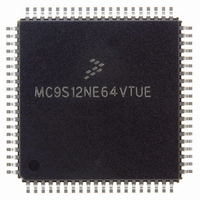MC9S12NE64VTUE Freescale Semiconductor, MC9S12NE64VTUE Datasheet - Page 273

MC9S12NE64VTUE
Manufacturer Part Number
MC9S12NE64VTUE
Description
IC MCU 64K FLASH EEPROM 80-TQFP
Manufacturer
Freescale Semiconductor
Series
HCS12r
Datasheet
1.MC9S12NE64VTU.pdf
(554 pages)
Specifications of MC9S12NE64VTUE
Core Processor
HCS12
Core Size
16-Bit
Speed
25MHz
Connectivity
EBI/EMI, Ethernet, I²C, SCI, SPI
Peripherals
POR, PWM, WDT
Number Of I /o
38
Program Memory Size
64KB (64K x 8)
Program Memory Type
FLASH
Ram Size
8K x 8
Voltage - Supply (vcc/vdd)
2.375 V ~ 3.465 V
Data Converters
A/D 8x10b
Oscillator Type
Internal
Operating Temperature
-40°C ~ 105°C
Package / Case
80-TQFP Exposed Pad, 80-eTQFP, 80-HTQFP, 80-VQFP
Processor Series
S12N
Core
HCS12
Data Bus Width
16 bit
Data Ram Size
8 KB
Interface Type
I2C, SCI, SPI
Maximum Clock Frequency
125 MHz
Number Of Programmable I/os
70
Number Of Timers
4
Operating Supply Voltage
- 0.3 V to + 3 V
Maximum Operating Temperature
+ 105 C
Mounting Style
SMD/SMT
3rd Party Development Tools
EWHCS12
Development Tools By Supplier
EVB9S12NE64E, DEMO9S12NE64E
Minimum Operating Temperature
- 65 C
On-chip Adc
10 bit, 8 Channel
Cpu Family
HCS12
Device Core Size
16b
Frequency (max)
25MHz
Total Internal Ram Size
8KB
# I/os (max)
70
Number Of Timers - General Purpose
4
Operating Supply Voltage (typ)
2.5/3.3V
Operating Supply Voltage (max)
2.625/3.465V
Operating Supply Voltage (min)
2.357/2.375/3.135V
Instruction Set Architecture
CISC
Operating Temp Range
-40C to 105C
Operating Temperature Classification
Industrial
Mounting
Surface Mount
Pin Count
80
Package Type
TQFP
For Use With
EVB9S12NE64E - BOARD EVAL FOR 9S12NE64DEMO9S12NE64E - DEMO BOARD FOR 9S12NE64
Lead Free Status / RoHS Status
Lead free / RoHS Compliant
Eeprom Size
-
Lead Free Status / Rohs Status
Lead free / RoHS Compliant
Available stocks
Company
Part Number
Manufacturer
Quantity
Price
Company:
Part Number:
MC9S12NE64VTUE
Manufacturer:
Freescale Semiconductor
Quantity:
10 000
Part Number:
MC9S12NE64VTUE
Manufacturer:
FREESCALE
Quantity:
20 000
- Current page: 273 of 554
- Download datasheet (4Mb)
9.4.2
The SPI operates in slave mode when the MSTR bit in SPI Control Register1 is clear.
Although the SPI is capable of duplex operation, some SPI peripherals are capable of only receiving SPI
data in a slave mode. For these simpler devices, there is no serial data out pin.
As long as no more than one slave device drives the system slave’s serial data output line, it is possible for
several slaves to receive the same transmission from a master, although the master would not receive return
information from all of the receiving slaves.
If the CPHA bit in SPI Control Register 1 is clear, odd numbered edges on the SCK input cause the data
at the serial data input pin to be latched. Even numbered edges cause the value previously latched from the
serial data input pin to shift into the LSB or MSB of the SPI shift register, depending on the LSBFE bit.
If the CPHA bit is set, even numbered edges on the SCK input cause the data at the serial data input pin to
be latched. Odd numbered edges cause the value previously latched from the serial data input pin to shift
into the LSB or MSB of the SPI shift register, depending on the LSBFE bit.
When CPHA is set, the first edge is used to get the first data bit onto the serial data output pin. When CPHA
is clear and the SS input is low (slave selected), the first bit of the SPI data is driven out of the serial data
output pin. After the eighth shift, the transfer is considered complete and the received data is transferred
into the SPI Data Register. To indicate transfer is complete, the SPIF flag in the SPI Status Register is set.
Freescale Semiconductor
•
•
•
SCK Clock
In slave mode, SCK is the SPI clock input from the master.
MISO and MOSI Pins
In slave mode, the function of the serial data output pin (MISO) and serial data input pin (MOSI)
is determined by the SPC0 bit and BIDIROE bit in SPI Control Register 2.
SS Pin
must be low. SS must remain low until the transmission is complete. If SS goes high, the SPI is
forced into idle state.
output pin is high impedance, and, if SS is low the first bit in the SPI Data Register is driven out of
the serial data output pin. Also, if the slave is not selected (SS is high), then the SCK input is
ignored and no internal shifting of the SPI shift register takes place.
The SS pin is the slave select input. Before a data transmission occurs, the SS pin of the slave SPI
The SS input also controls the serial data output pin, if SS is high (not selected), the serial data
Slave Mode
When peripherals with duplex capability are used, take care not to
simultaneously enable two receivers whose serial outputs drive the same
system slave’s serial data output line.
A change of the bits CPOL, CPHA, SSOE, LSBFE, MODFEN, SPC0 and
BIDIROE with SPC0 set in slave mode will corrupt a transmission in
progress and has to be avoided.
MC9S12NE64 Data Sheet, Rev. 1.1
NOTE
NOTE
Functional Description
273
Related parts for MC9S12NE64VTUE
Image
Part Number
Description
Manufacturer
Datasheet
Request
R
Part Number:
Description:
Manufacturer:
Freescale Semiconductor, Inc
Datasheet:
Part Number:
Description:
Manufacturer:
Freescale Semiconductor, Inc
Datasheet:
Part Number:
Description:
Manufacturer:
Freescale Semiconductor, Inc
Datasheet:
Part Number:
Description:
Manufacturer:
Freescale Semiconductor, Inc
Datasheet:
Part Number:
Description:
Manufacturer:
Freescale Semiconductor, Inc
Datasheet:
Part Number:
Description:
Manufacturer:
Freescale Semiconductor, Inc
Datasheet:
Part Number:
Description:
Manufacturer:
Freescale Semiconductor, Inc
Datasheet:
Part Number:
Description:
Manufacturer:
Freescale Semiconductor, Inc
Datasheet:
Part Number:
Description:
Manufacturer:
Freescale Semiconductor, Inc
Datasheet:
Part Number:
Description:
Manufacturer:
Freescale Semiconductor, Inc
Datasheet:
Part Number:
Description:
Manufacturer:
Freescale Semiconductor, Inc
Datasheet:
Part Number:
Description:
Manufacturer:
Freescale Semiconductor, Inc
Datasheet:
Part Number:
Description:
Manufacturer:
Freescale Semiconductor, Inc
Datasheet:
Part Number:
Description:
Manufacturer:
Freescale Semiconductor, Inc
Datasheet:
Part Number:
Description:
Manufacturer:
Freescale Semiconductor, Inc
Datasheet:











